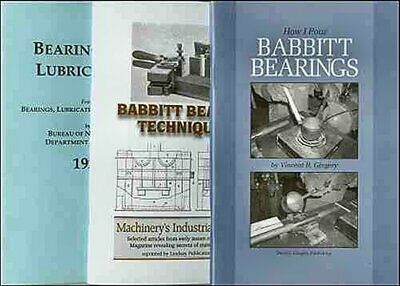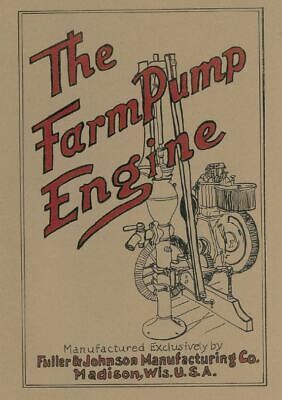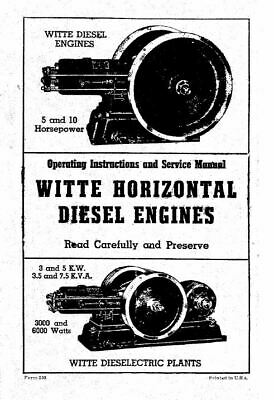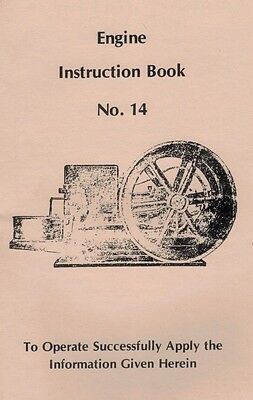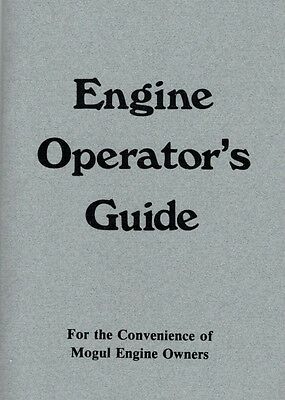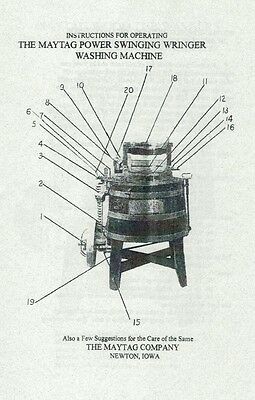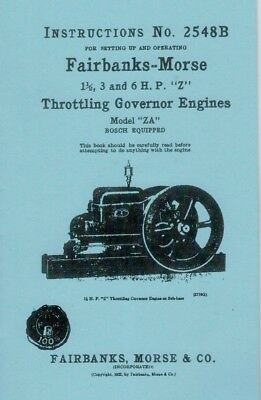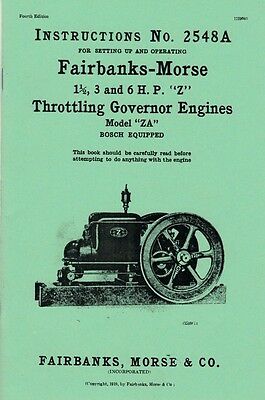-40%
THREE Books on Do It Yourself Pouring of BABBITT BEARINGS
$ 9.49
- Description
- Size Guide
Description
What you get here are the two useful books on re-surfacing and re-pouring babbit bearings, plus one on how the Navy did it in 1928.How I Pour Babbitt Bearings
, by Vince Gingery, who is ably carrying on his father’s great tradition of Do-It-Yourself metalworking
Babbitt Bearing Techniques
, a compilation of shop hints and tips pulled out of early 1900s
Machinery
magazines, and
Bearings and Lubrication
, one of the first little booklets we reproduced (back in 1999), taken from a 1928 U.S. Navy book,
Bearings, Lubrication and Propellers
.
Here is more detail on each of these three books:
How I Pour Babbitt Bearings
, by Vince Gingery, published by Gingery Publications, 2001. 5½ x 8½ paperback, 43 pages. ISBN 1-878087-24-X.
This is a detailed, step-by-step explanation of how to rebabbitt bearings on old machinery and tractors. Essentially, you look over Vince's shoulder as he restores a saw-mill arbor to like-new condition. He's certainly not inventing anything new, rather he's showing you how you can do the job today. Vince writes that
Babbitt metal is a soft, white, anti-friction alloy, the formula of which was developed in 1839 by Issac Babbitt. His original formula consisted mainly of tin, copper and antimony. But since then, others have experimented with the original formula by adding lead as well as other elements. As a result of this experimentation, quite a variety of white, silvery alloys with varying characteristics have been developed. This group of alloys known as the "White Metals" have been used for everything from machine bearings, packings and linings, to toys, ornaments and fusible metals.
Prior to 1940 just about every machine built used Babbitt bearings, and every mechanic was familiar with them. If, today, you ask the average guy under 40 years of age if he has ever heard of Babbitt you will likely get a blank stare. And when you try to explain it, the reply might be something like, 'that's old technology, who needs it, and who cares'.
Many of us get a great deal of satisfaction from restoring old tools, machinery and automobiles that are destined for the scrap yard. We find that there is a lot of old, heavily-built machinery built to last still available at scrap prices. Often all that is required to put one of these machines back in working order is cleaning and painting individual parts and re-pouring the Babbitt bearings.
This little booklet contains the basic information you need to melt and pour, in other words, restore Babbitt bearings. Topics include: bearing metal requirements, Babbitt availability, safety, cleaning the shell, anchoring the Babbitt, tinning, set up, melting, preheating, pouring and finishing the bearing etc.
In addition, you should consider making your own bearings from scratch. You will be amazed at how simple it is. It's a valuable skill for those of us who design and build our own machine tools. Light duty, low cost pillow block bearings are still available. When you price a set of heavy duty pillow blocks for a saw mill arbor or surface grinder, however, you quickly realize the value of being able to make such items yourself.
Table of Contents
Introduction
Bearing metal requirements
History
Types of bearing metals
Babbitt availability
Safety first
The process
Cleaning the shell
Anchor holes
Tinning
Mandrels
Setup
Choosing a melting pot
Melting the Babbitt
Preheating the shell
Pouring the lower bearing
Pouring the bearing cap
Bearing lubrication
Finishing the bearing
Peening
Bearing clearance
10 point review
Conclusion
Babbitt Bearing Techniques: Machinery’s Industrial Secrets
, originally published in
Machinery
magazine in the early 1900s, compiled by Lindsay Publications, published by Lindsay Publications, 2000. 5½ x 8½ paperback, 48 pages. ISBN 1-55918-244-X.
These days we use bronze bushings, ball bearings, and roller bearings. At one time, though, bearings were cast from Babbitt metal, an alloy of tin, antimony and lead. It was very similar to type metal used in Linotype machines or solder. It was also called soft metal or white metal.
Modern knuckleheads laugh at Babbitt. It "couldn't possibly" be any good because it is so soft. "Only modern bearings" are any good. Bull! It was excellent bearing material, but the main reason we don't use it these days is because modern bearings can be much smaller to carry a given load, need essentially no maintenance, and they're now mass-produced making them cheap. A hundred years ago, Babbitt was king.
Many people are not familiar with the technique. For instance you might have a cast iron shell for a pillow block. You place the drive shaft through the shell and center it with a simple jig. You melt Babbitt with a torch (propane will do) and pour it into the space between the shaft and the shell. In a couple of minutes the metal has frozen, and you can remove the shaft and check the result. To use your homemade pillow block just put the shaft back into the bearing being sure to supply adequate lubrication. It will run and run and run. It's cheap, fast, and inexpensive. And it performs. Some of the finest lathes ever made had Babbitt headstock bearings.
These articles are full of drawings, how-to, arguments among machinists, experiments, discoveries, and experience. Babbitting is something to learn about and use. Afterall, most early 1900's engines - marine, airplane, steam, automobile - used Babbitt in their bearings for good reason. These articles from early issues of Machinery Magazine reveal discussions among WW I era machinists about their techniques, secrets, and discoveries.
Topics include
Making Babbitted Bearings in Halves
Numerous Babbitting mandrels
Centering jigs
Special jigs for special jobs
Babbitting and Planing Cross Head Gibs
A variety of Babbitt Bearing Molds
Use of Soft Metals in Machinery Construction
Anchoring White Metal
Lining Bearings with Babbitt Metal
Babbitted Machinery Construction
Alignment Babbitting
Babbitting Cross-Heads
Lining Cast-Iron Bearings with Babbitt Metal
Standard Babbitt Specifications
Babbitting Fixture for Small Bearings
Oil Channels in Babbitt Bearings
Bearings and Lubrication
, from
Bearings, Lubrication and Propellers
, originally published in 1928 by the Bureau of Navigation, Department of the Navy. Reprinted in 1999 by Nation Builder Books, Leesburg, VA. 5½ x 8½ paperback, 33 pages.
Keep in mind that the Navy Bureau of Navigation people probably wrote this for officers and seaman dealing with LARGE engines weighing several or even hundreds of tons. Still, you will probably find many useful hints and tips, especially in the section on inspection and care of bearings.
Table of Contents:
Bearings and Shafting: Requirements for Successful Operation
Bearing requirements
Bearing area
Characteristics of bearing metals
Navy Department specifications for bearing metals
Oil supply
Bearing adjustments
General discussion of alignment
Aligning bearings
Alternate method of lining up bearings
Lining up spring bearings
Allowance for sag of wire
Method of installing line shafting
Alignment of shafting
Origin of alignment
Raising or lowering the shaft
Flange method of checking alignment
Bearing Clearance
Bearing clearance
Factors governing clearance
Liners
Oil clearance for various bearings
Taking a lead
Placing leads on journals
Precautions while taking a lead
Examination and measurement of leads
Marking bearing nuts
Adjusting a bearing by feel
Alternate method of setting oil clearance
Bearing clearance for reciprocating engines
Necessity for knowledge of bearing pressures
Point of delivery of oil to bearing
Beveling sides of bearings
Origin of pressure sustaining the oil film
Effect of grooving turbine bearings
Grooving of turbine bearings
Grooving low-speed reciprocating engine bearings
Extent of grooving
Shape of grooves
Lignum-vitae bearings
Stern tubing
Strut bearing
Stern-tube stuffing box
Stern-tube and stern-bracket clearances
Inspection in dock
Inspection and Care of Bearings
Causes and Treatment of Hot Bearings
Procedure when bearing begins to heat
Hot bearing
Items involved in a heated bearing
Steps to take to restore bearing to normal temperatures
Procedure if trouble is inherent in bearing
General summary of procedure
Procedure with a “wiped” bearing
Care and Repair of Bearings and Journals
Bridge gauge reading of bearings
Form for bearing records
Treatment of journals
Running heat of bearings
Care during first few minutes of operation
Measurement of wear on gear wheel and pinion bearings
Rolling out lower half of bearing
Materials to use in cleaning
Inspection of bearing for condition
Precautions while rebabbitting
Rebabbitting a bearing
Centrifugal method of babbitting bearings
Spotting and fitting a bearing
Use of bearing compounds
Grinding in a bearing
Clean thoroughly after grinding
Precaution against compound entering lubricating system
Grinding mixture
Safety precautions
